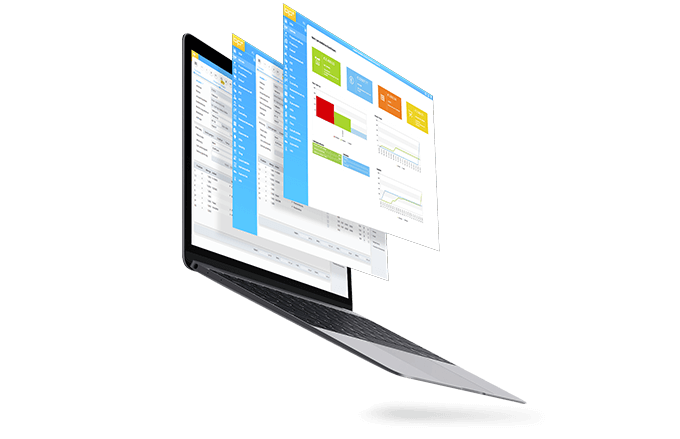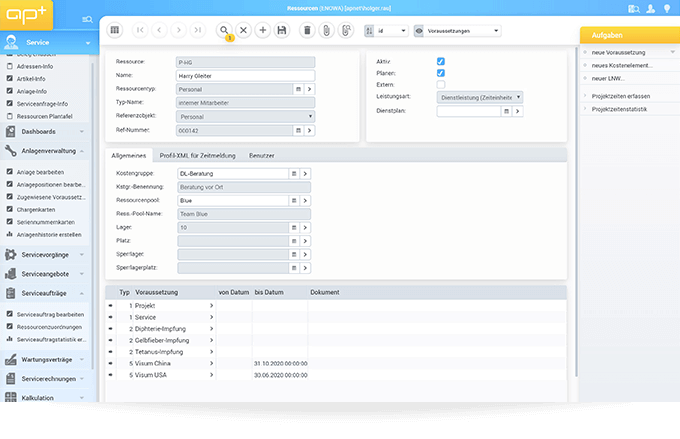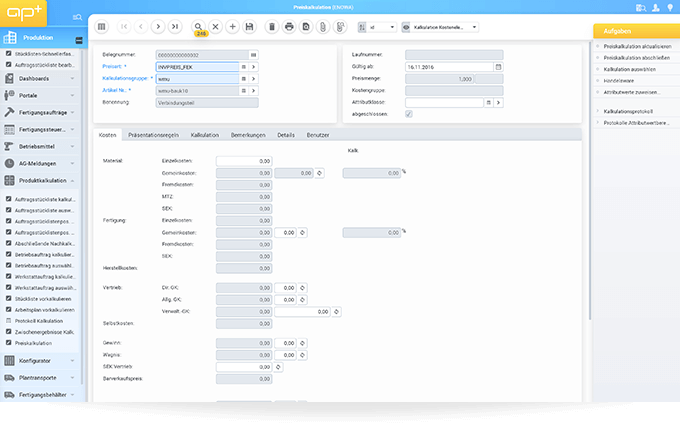
The future of production logistics starts now
With the intelligent PPC solution from APplus, you have the entire production process on your screen. The state-of-the-art production logistics tool meets the requirement for increasingly shorter throughput and delivery times. This allows you to respond more quickly and reliably to changes in delivery schedules
Components of our PPS feature

- Parts lists and work plans
- Operating resources management
- Product development / EDM / PLM integration
- Graphical resource planning board
- Product Configurator
Bills of materials and work plans
Resource management
Materials and time are not the only factors important in manufacturing. The availability and quality of operating resources are also often critical factors. In order to manufacture high-quality products in a timely fashion, information relating to the quantity, quality, and operational readiness of all a company‘s operating resources is always available in APplus - whether for highly complex shaping equipment or simple inspection equipment.
Product development/ EDM/PLM integration
The characteristics table (according to DIN 4000) of APplus is also frequently an important streamlining tool for assemble-to-order companies. It enables appropriate parts to be located quickly during development, thereby reducing the diversity of parts.
The integration for the PRO.FILE PDM system and APplus enables genuine online collaboration between both systems. Thus it provides cross-system maintenance and provisioning of development and production data for efficient and consistent business processes in Product Lifecycle Management. After being released, BOMs created in the CAD system are immediately available in production. The cross-department process is ensured.
The characteristics table (according to DIN 4000) of APplus is also frequently an important streamlining tool for assemble-to-order companies. It enables appropriate parts to be located quickly during development, thereby reducing the diversity of parts.

The integration for the PRO.FILE PDM system and APplus enables genuine online collaboration between both systems. Thus it provides cross-system maintenance and provisioning of development and production data for efficient and consistent business processes in Product Lifecycle Management. After being released, BOMs created in the CAD system are immediately available in production. The cross-department process is ensured.
The standard integration of CAP2 (CAP2+) from N+P integrates standard market-leading 2D and 3D CAD systems such as Inventor, AutoCAD, Solid Edge, and the Productstream Compass Pro PDM system into APplus. In addition, there is simplified CAD integration for importing BOMs into APplus via Excel using SLIMP2+.
The Web service architecture of APplus pays off particularly in these areas. APplus gives design engineers and production scheduling employees access to information that is up-to-date and consistent for everyone involved—even though each department operates solely with its own legacy system: Design engineers use CAD and the integrated EDM/PDM system, and the employees in scheduling or procurement use the PPC module from APplus.
Resource planning
APplus sets the benchmark in resource planning. Materials, machines, staff, and, if necessary, other resources such as operating resources are planned in a single cycle, against available capacity in the simplest-case scenario. Bottlenecks, or alternatively all capacity centers, can also be planned with limited capacity.
Planning results are presented to the scheduler in detailed graphical format (Gantt chart). Any required fine adjustments or corrections can be made right in the planning board.
Award-winning ERP solution
for medium-sized companies
Top marks Trovarit study 2018/2019
Awarded ICT product of the year
CrefoZert: Certified very good credit rating
Multiple award winning ERP system
APplus has been rated ERP system of the year across various categories for several years in a row.
Planning board
The APplus planning board ensures optimum overview over all pending production orders for all or selected capacity units. Based on the implemented zoom functions, the view can be scaled from one day to entire weeks or months.When you select a workflow represented by a bar on the timeline, all important order information is displayed automatically and dependent workflows are highlighted.
The lower section of the split screen shows the overall capacity graph for the relevant capacity. If necessary, workflows can be rescheduled using drag and drop.Within the special view for projects, you have the ability to split up activities multiple ways and distribute them along the time axis as needed. The flexible adaptability of the module also enables you to generate additional company-specific views or functions.
Product Configurator
Assemble-to-order companies value the performance capability of the Product Configurator from APplus: Alternative items in BOMs or work plans, simple formulas for variations in quantity or size are already covered by the base system. Beyond this, complex product logic for the sales and production area can be mapped consistently. New technologies such as XML and C# let you reach previously unknown levels of flexibility and productivity in designing product-descriptive logic. Users oriented more towards traditional applications can also rely on the tried-and-true tool of decision tables.
New technologies such as C# and XML enable unprecedented productivity and flexibility in the construction of product-describing logics. Of course, the tried and tested decision tables are still available to more classically oriented users.
Production controlling and product costing
The extensive costing functions provided by APplus are of great importance for optimizing the production process and for business success. Detailed, production-oriented preliminary costing, concurrent costing and final costing, including detailed variance analyses, meet all requirements. Contract manufacturers in particular value the options for assigning all costs directly to the pegged order: Stock material, in-house production, external production or travel costs of technicians and even all order-related procurement transactions including all additional costs to be charged. Repetitive manufacturers are usually more likely to use standard cost accounting, which APplus offers as an alternative.
Contract manufacturers particularly appreciate the possibility of allocating all costs directly to the order that caused them. This includes stock material, in-house and external production and travel expenses for fitters, as well as all order-related procurement processes including additional costs to be allocated. Repeat manufacturers usually prefer the standard cost accounting that APplus offers as an alternative.
The extensive costing functions provided by APplus are of great importance for optimizing the production process and for business success. Detailed, production-oriented preliminary costing, concurrent costing and final costing, including detailed variance analyses, meet all requirements. Contract manufacturers in particular value the options for assigning all costs directly to the pegged order: Stock material, in-house production, external production or travel costs of technicians and even all order-related procurement transactions including all additional costs to be charged. Repetitive manufacturers are usually more likely to use standard cost accounting, which APplus offers as an alternative.
The extensive costing functions provided by APplus are of great importance for optimizing the production process and for business success. Detailed, production-oriented preliminary costing, concurrent costing and final costing, including detailed variance analyses, meet all requirements. Contract manufacturers in particular value the options for assigning all costs directly to the pegged order: Stock material, in-house production, external production or travel costs of technicians and even all order-related procurement transactions including all additional costs to be charged. Repetitive manufacturers are usually more likely to use standard cost accounting, which APplus offers as an alternative.
Contract manufacturers particularly appreciate the possibility of allocating all costs directly to the order that caused them. This includes stock material, in-house and external production and travel expenses for fitters, as well as all order-related procurement processes including additional costs to be allocated. Repeat manufacturers usually prefer the standard cost accounting that APplus offers as an alternative.
Shop floor control
The shop floor control module enables paperless completion of production orders. It also gives production employees the ability to process workflows in an optimized sequence, taking into account released orders and specified deadlines. This gives shop floor staff greater responsibility and leeway in making decisions.
Both the process chains of production as well as the activities for the employees in production are controlled in APplus via the status of the workflow. The scheduler explicitly releases the workshop orders for production. Then the information about the capacity situation and the availability of the needed materials is available to him or her. Production employees see all activities they have to carry out on their login screen. They also receive information about the materials they need. Moreover, APplus supports shop floor control for the following tasks:
- Production release of workshop orders
- Capacity analysis via operations
- Prioritisation of workshop orders
- Carrying out availability checks
- Capacity analysis
- Display of pending operations and order time recording functions (via WSS terminal).


